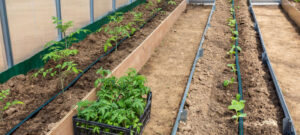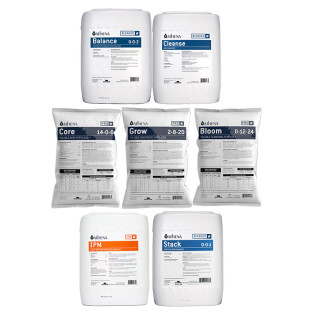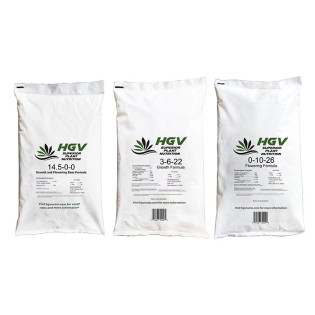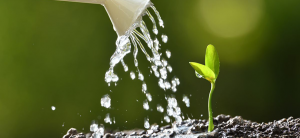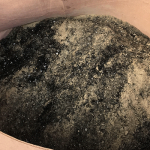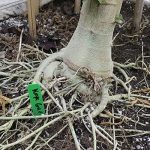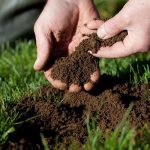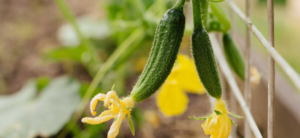
Your garden is beautiful and bountiful, however, it can be too much to manage and water on a daily basis. As your garden grows it becomes more important to find an easy way to water your plants.
Drip irrigation systems are a popular way to water plants in outdoor gardens, greenhouses, and even indoor hydroponic gardens. Here at Hydrobuilder we highly recommended this method to water plant and vegetable gardens.
What is Drip Irrigation?
Drip line irrigation works by providing water and nutrients directly to the plant's root zone. This system is designed to restrict water usage, reduce evaporation, and provide plants with the ideal amount of water.
This garden watering system is a controlled and efficient way of irrigating plants in farming, gardens, raised beds, and potted plants.
Benefits of Drip Irrigation
In drip irrigation, water is released slowly near the root zone of plants, minimizing wastage. This approach offers several advantages over traditional methods of irrigation, such as overhead sprinklers:
- Water Efficiency: Drip irrigation significantly reduces water wastage by delivering water directly to the plant's root zone, minimizing evaporation and runoff.
- Less Erosion: Water is applied slowly and evenly, reducing soil erosion caused by heavy watering.
- Fertilizer Efficiency: Some drip irrigation systems allow for the controlled delivery of fertilizers directly to the plant roots, increasing nutrient efficiency.
- Flexibility: Drip systems can be customized to suit various types of plants, soil types, and terrain.
- Fewer Weeds: Since water is targeted at the plants' roots, there is less weed growth.
Less Disease Issues: The leaves of plants are less likely to get wet, reducing the risk of disease. This is especially true in crops that are sensitive to waterborne illnesses.
How Does Drip Irrigation Work?
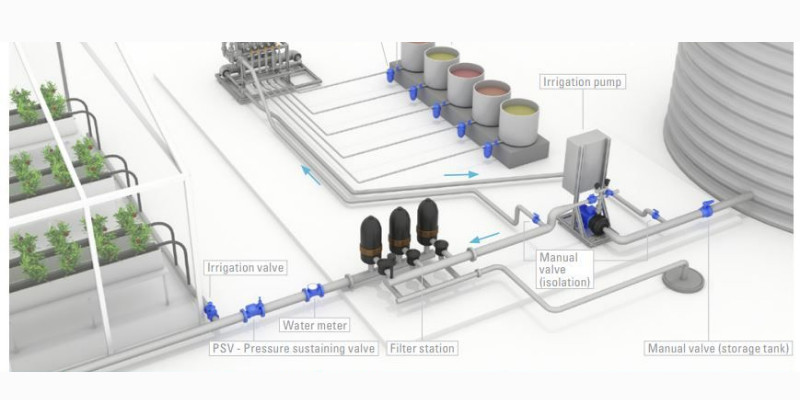
Drip irrigation, also called micro-irrigation, delivers water to plants using irrigation tubing, fittings, and drippers.
Water Source: A micro irrigation system starts with a water source. This can be a water tank, a well, a city water supply, or other clean water sources. The water is typically filtered to remove debris and sediment that can clog the drippers.
Main Supply Line: From the water source, a main supply line is connected to deliver water to the irrigation area. This line is usually made of durable pipes such as PVC pipe that can withstand the pressure of the water flow.
Control Valves and Pressure Regulators: Valves and regulators are often included in the system to control the flow rates of water. This helps maintain consistent water pressure throughout the system. This ensures that each emitter delivers a consistent amount of water.
Sub-Lines: The main line is attached to sub-main lines, which are smaller hoses that send water to the area to be irrigated.
Lateral Lines: From the sub-main lines, smaller micro lines extend to individual plants.
Emitters (Drippers): Along the length of the lateral lines, emitters or drippers are installed at specific intervals. These emitters release water in the form of small droplets.
Placement of Emitters: Drppers are placed by the root zone of each plant. This allows water to reach the area where the plant needs it most.
Automation: Drip irrigation systems can be manually controlled or automated using timers and sensors. Timers allow you to schedule when the system turns on and off, ensuring that plants receive water at optimal times. Sensors can measure soil moisture levels and adjust irrigation based on conditions.
Types of Drip Irrigation
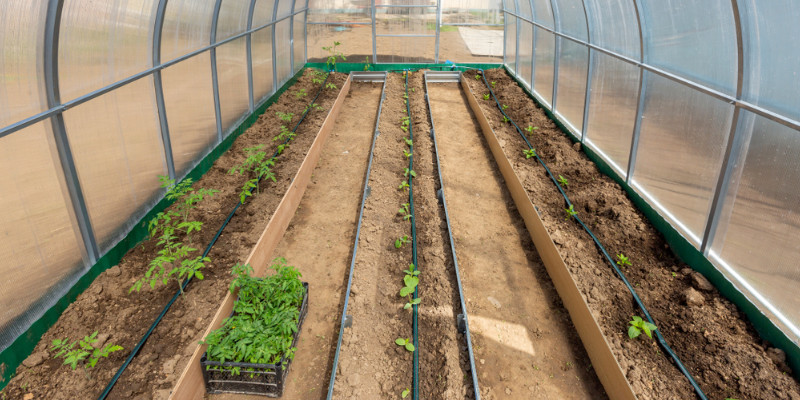
There are several types of drip irrigation methods, each with its own features and advantages. Picking the type depend on factors like the size of the area, plant types, and budget.
Below we break down a few of the most popular types of drip line irrigation systems.
Surface Systems
A surface system is a type of drip irrigation that delivers water to the soil surface and root zone of plants. Unlike subsurface drip systems, where the tubing is buried, the components of a surface drip system are placed above the soil.
This type of system is commonly used in various agricultural, horticultural, and landscaping applications.
Sub-Surface Systems
A sub-surface system is a type of drip system where the tubing and emitters are buried underground. This sends water to the roots like other systems but with the benefit of placing the parts below the soil surface.
Micro Sprinkler Systems
This is a hybrid between traditional sprinklers and drip irrigation. Micro sprinklers release small droplets or a fine mist of water, covering a broader area than individual emitters. They are suitable for covering plants with larger canopies, like shrubs and flowering plants.
Drip Tape Systems
Drip tape is a flat, thin tube with emitters that allow water to seep out along its length. It's commonly used in row crops and larger farming fields. Drip tape can be buried under the soil, making it less prone to wear.
Designing Your DIY Drip Irrigation System
Drip irrigation systems can range from simple setups for home gardens to more complex systems used in large-scale agricultural operations.
The irrigation supplies of a typical drip system are mentioned above. This includes a water source, main supply lines, sub-main lines, lateral lines, and drippers that deliver water to each plant.
The system can also include filters to prevent clogging, pressure regulators, and timers for automated watering schedules.
Need Help Designing & Planning Your New Drip Irrigation System?
Are you needing to set up a drip system for your garden? If you dont know where to start, we are here to help!
We will help to create a proper layout and define the ideal flow rates for your specific needs. We can also help you purchase all the needed parts to get the system fully set up!
From there we can help with any installation questions you may have while setting up your drip irrigation system. Give us a call at 888-815-9763 to speak with a growing expert today!
Drip Irrigation Kits
If DIY drip irrigation is not for you, consider using a drip irrigation kit. These kits include all the essential parts, pre-cut and ready to install. We offer many different pre-assembled kits based on the number of plants, pot size, and spacing.
FAQs about Drip Irrigation
How Long & Often Should I Run Water With Drip Irrigation?
The duration for which you should run water with drip irrigation depends on various factors. This includes the type of plants you're watering, the soil type, weather conditions, and the specific needs of the plants.
As a general starting point, consider running your system for about 30 minutes to an hour, 2-3 times per week.
What Time of Day Is Best for Drip Irrigation?
Early morning is often considered the best time for irrigation. Watering in the early morning hours, just before sunrise, has several benefits:
- The air is cooler, which reduces evaporation, ensuring that more water reaches the plants' root zones.
- Plants have a chance to absorb the moisture before the heat of the day sets in.
- The foliage has time to dry out during the day, reducing the risk of fungal diseases that thrive in damp conditions.
- Watering early in the day also helps to energize plants and prepare them for the day's growth.
How Long Do Drip Irrigation Systems Last?
The lifespan of a system can vary widely depending on factors. These include the quality of components, installation practices, maintenance, and environmental conditions.
However, with proper design, installation, and maintenance, drip irrigation systems can typically last anywhere from 5 to 25 years or more.
Regular inspections, along with prompt repairs as needed, can significantly extend the life of your drip system. While some components might need replacement over time, a well-maintained system can serve you well for many years.
What Crops Benefit From Drip Irrigation?
Drip irrigation is a versatile method of irrigation that can be used for a wide range of crops. This can include agricultural crops, horticultural plants, and landscaping vegetation.
Plants that benefit from drip irrigation include; vegetables, fruit, herbs, field crops, nursery plants, greenhouse crops, landscaping, medicinal plants, and more.
Using drip irrigation for a specific crop depends on factors like the crop's water needs, root structure, spacing, and growth patterns. It's important to tailor the drip irrigation system to the unique needs of each crop to maximize its benefits.
Final Thoughts On Drip Irrigation
Overall, drip irrigation offers an efficient way to provide water to plants while reducing waste, supporting healthy growth, and saving resources.
We highly recommend our customers use this method of plant watering for their gardens, and you should too!





